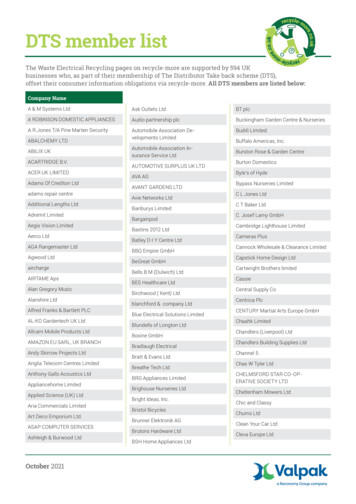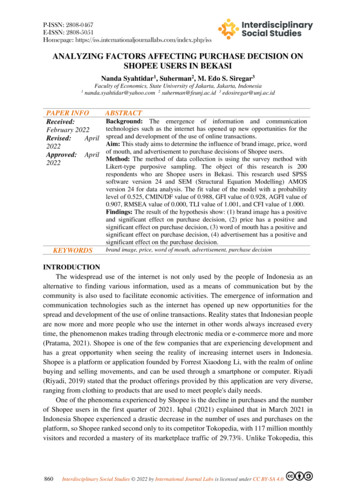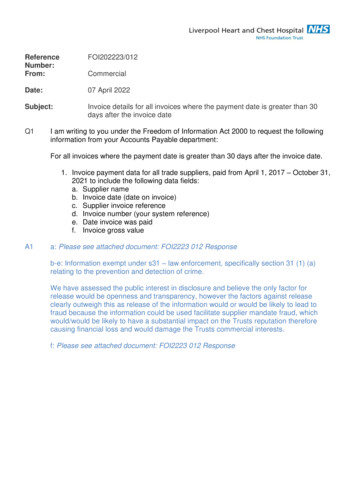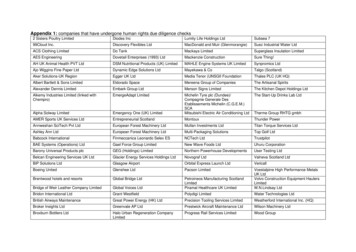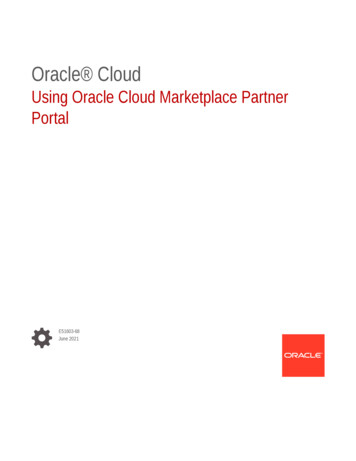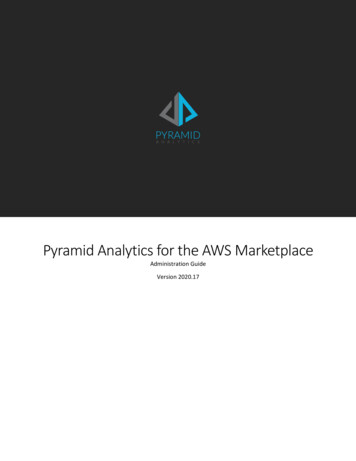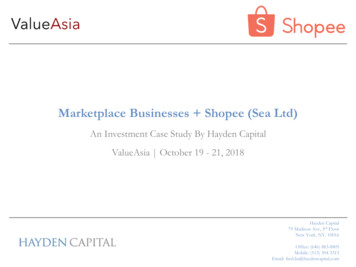
Transcription
Marketplace Businesses Shopee (Sea Ltd)An Investment Case Study By Hayden CapitalValueAsia October 19 - 21, 2018Hayden Capital79 Madison Ave, 3rd FloorNew York, NY. 10016Office: (646) 883-8805Mobile: (513) 304-3313Email: fred.liu@haydencapital.com
DisclaimerThese materials shall not constitute an offer to sell or the solicitation of an offer to buy any securities, or interests in any fund oraccount managed by Hayden Capital LLC (“Hayden Capital”) or any of its affiliates. Such an offer to sell or solicitation of an offer tobuy will only be made pursuant to definitive subscription documents between a fund and an investor.Hayden Capital may have positions in any securities mentioned in this report. Following publication of the report, Hayden Capitalmay transact in the securities of the company covered herein, including selling or buying the securities. All content in this publicationrepresents the opinions of Hayden Capital. Hayden Capital has obtained all information referenced from sources they believe to beaccurate and reliable. However, such information is presented “as is,” without warranty of any kind – whether express or implied.Hayden Capital makes no representation, express or implied, as to the accuracy, timeliness, or completeness of any such informationor with regard to the results obtained from its use. All expressions of opinion are subject to change without notice, and HaydenCapital does not undertake to update or supplement this report or any information contained herein. This report isnot a recommendation to purchase the securities of any company.The fees and expenses charged in connection with the investment may be higher than the fees and expenses of other investmentalternatives and may offset profits. No assurance can be given that the investment objective will be achieved or that an investor willreceive a return of all or part of his or her investment. Investment results may vary substantially over any given time period.Reference and comparisons are made to the performance of other indices (together the “Comparative Indexes”) for informationalpurposes only. Hayden Capital’s investment program does not mirror any of the Comparative Indexes and the volatility of HaydenCapital’s investment strategy may be materially different than that of the Comparative Indexes. The securities or other instrumentsincluded in the Comparative Indexes are not necessarily included in Hayden Capital’s investment program and criteria for inclusion inthe Comparative Indexes are different than those for investment by Hayden Capital. The performance of the Comparative Indexeswas obtained from published sources believed to be reliable, but which are not warranted as to accuracy or completeness. Unlessnoted otherwise, the returns of the Comparative Indexes presented do not reflect fees or transaction costs, but those returns doreflect net dividends, if any.Fred Liu, CFA 646-883-8805 fred.liu@haydencapital.com2
Who Is Hayden Capital?Investment Strategy: We invest primarily via a long-biased, low-turnover, global equity strategy. Investments are under-written witha 10 year view. The goal is to compound our capital in-line with these businesses’ growth in earnings power. We focus on underlying business unit economics, as opposed to market factors like sentiment or multiple expansion, as thesource of our returns. Our typical portfolio comprises of 6 – 15 high-quality companies, that we have studied for an extensive period. We don’t aim to “beta-hedge” our positions, as this typically results in sacrificing long-term gains for reducing short-termvolatility. As long-term investors, we would rather have a superior (although lumpy) annual return, than a steady (but mediocre)return. In fact, we embrace volatility in most cases as it allows us to purchase companies we like for cheaper.Investment Objective: Achieve returns exceeding the broader Global Equity Markets (measured by the S&P 500 and MSCI World),over a full market cycle. Hayden Capital seeks to achieve these returns primarily through publicly traded, marketable securities of U.S.and non-U.S. companies. No complex derivatives, “pair-trades”, or significant use of leverage. All accounts are Separately Managed Accounts (“SMAs”), as opposed to a pooled structure. We think this is in the best interestsof our clients, as it provides clients full ownership of their investments, daily liquidity, and transparency.Fred Liu, CFA 646-883-8805 fred.liu@haydencapital.com3
About MeFred Liu, CFAManaging PartnerFred Liu is Hayden Capital’s founder and portfolio manager. Heholds a B.S. in finance and international business from the LeonardN. Stern School of Business at New York University. He also holdsthe Chartered Financial Analyst (CFA) designation.Prior to founding Hayden Capital, Fred was a research analyst atNew Street Research responsible for covering the cable and satelliteindustries. Before this, he was the industrials analyst on J.P.Morgan’s Small Cap Equity fund, a five-star Morningstar rankedstrategy that invested in securities under 2 Billion in market cap.Fred purchased his first stock at the age of 11, and has been an avidvalue investor ever since. He currently resides in New York City.Fred Liu, CFA 646-883-8805 fred.liu@haydencapital.com4
Marketplace E-commerce (C2C)The gateway drug to an online shopping addiction Fred Liu, CFA 646-883-8805 fred.liu@haydencapital.com5
Southeast Asia – The Next BattlegroundCompared to other regions, Southeast Asia is still in the very nascent stages of e-commerce development. Only 3% of retail sales is conducted online, vs. 9% - 18% for other Asian countries. Market shares tend to stabilize at 10% e-commerce penetration, so there’s still a lot of “white space” for market shares to shiftamong incremental customers.Southeast Asia PopulationFrom Sea Ltd Investor PresentationE-Commerce Penetration Rates – By CountryFor 2017-1835.4%18.0%12.7%10.0%United Fred Liu, CFA 646-883-8805 0%JapanSoutheastAsiaGrowth Rate6
If You Were To Start an Online Retail Platform, What Would it Look Like?When launching an online marketplace in Southeast Asia, most likely you’d want it to have the following qualities:ProblemSolutionSoutheast Asia is Mobileoriented Mobile-first Business ModelLack of Trust BuyingOnline Focus on Cheap Categories (i.e. Fashion), where the purchasedecision is easier (if it’s a fake, it’s not a huge deal).Build trust over time, as customers order more often. Many Competitors Make the product addictive. Fashion is a category whereshopping is a form of entertainment, and has the highest orderfrequencies.Fashion marketplaces often have average engagement of 1hour per day, and order rates of 3 – 5x per month. This isespecially true in emerging economies, with fewerentertainment options.The longer customers browse your store, the more likelythey’ll find something to buy.Need to Offer WideSelection of Products, WithLimited Capital C2C Marketplace model.This is the quickest way to offer a wide selection of products,while remaining asset-light.How Do You Offer LowPrices, When You Don’tControl the Product? Promote a robust seller ecosystem. With enough sellerscompeting against each other for the order, naturalcompetition will result in the lowest price at equilibrium.Fashion is also a category where there’s great diversity, and it’sunlikely multiple sellers will have the same exact product.Small details / design differences can justify pricingdifferences. ShopeeFred Liu, CFA 646-883-8805 fred.liu@haydencapital.com7
Marketplaces Are Like Self-Regulating EcosystemsImagine you are building a new city from scratch (think Abu Dhabi). How would you attract inhabitants & visitors to develop arobust economy?Starting a marketplace is very similar. It requires a large initial investment (subway systems vs. IT systems; tax breaks to encouragebusinesses to relocate there vs. free shipping for buyers to visit, etc), to hopefully create a self-sustaining economy in the future. In a marketplace, the company is like a King, determining the laws / rules of conduct, while also adding features that make itattractive to inhabitants vs. other ecosystems (free shipping, ease of listing, buyer data, etc). The sellers on the platform are inhabitants, interacting with each other and to maximize their own well-being, while stayingwithin these rules. Buyers are like tourists, looking for the most diverse, dynamic, cheapest, and easiest cities to visit and spend their money. Once the ecosystem is self-sustaining, the company monetizes by “taxing” all transactions. The inhabitants stay, because despitethe new taxes, the living standards are still better than elsewhere (it’s better to collect 1,000 of tourist dollars and pay 10% tax,vs paying 0% tax elsewhere, but only selling 10).Better yet, the “taxes” (i.e. take-rate) increases, as sellers to compete against each other to collect an even bigger share of “touristdollars”. The more that seller pay for services like Advertising, Logistics, etc, the more likely they’ll be at the front of the line. More sellers more competition to be at the front higher revenues for the company.Note: Similar to evolution, the larger an ecosystem, the more diversity of inhabitants (in this case SKUs). This is important for categories like fashion, wherebrowsing is a fun experience, and variety is a main selling point of a platform. Imagine how boring it’d be going to a mall with just 5 stores, vs. one with 1,000’s of stores.Fred Liu, CFA 646-883-8805 fred.liu@haydencapital.com8
Marketplaces Are Like Self-Regulating EcosystemsBuyers:“What is that rapidlygrowing ecosystem overthere? It seems like there’sa lot more variety in itversus the others lets gocheck it out”Sellers:“Hey, look at all theseBuyers showing up. Whywould we go to Lazada orTokopedia, when there’smore customers in thisecosystem?”Shopee’s ExternalFunding:“We need to pump up thisecosystem large enough tobe self-sustainable, and soit doesn’t collapse.We’ll then make our realmoney, once everyone’saddicted to our platform,we can start “taxing” ourinhabitants, and sellerscompete with each other,and thus “bribe” us to putthem at the front of theline.”LazadaTokoBlibliShopeeFred Liu, CFA 646-883-8805 fred.liu@haydencapital.com9
These Ecosystems Are Being Developed All Across Southeast Asia Southeast Asia is very diverse, with currently little cross-border transactions. Investors must think of each country as a separatesubsidiary, each with their own odds at success. This makes it both more resilient (losing in one country won’t affect its chancesin another), while losing some of the natural benefits to scale a larger homogeneous consumer base would provide.Shopee’s headquarters is in Singapore, and should be thought of as the “brains” behind this multi-legged model.Fred Liu, CFA 646-883-8805 fred.liu@haydencapital.com10
Shopee OverviewShopee is a leading e-commerce platform (C2C) in Southeast Asia. The company was launched as a subsidiary of Sea Ltd (NASDAQ:SE) in 2015. Chris Feng (CEO) is ex-Zalora (Rocket Internet), and has staffed the firm with many ex-Zalora colleagues.– He was originally hired to be part of Garena (gaming business). It was only after they saw the amount of peer-to-peerselling taking place on their BeeTalk chat program, that Chris recognized the opportunity and ran with it.– Conversations with employees indicate he’s smart, drives his team hard, and now living almost full-time in Indonesia.– Zalora was a specialized Fashion marketplace in the Southeast Asia, and has largely wound-down after Alibaba’s purchaseof Lazada and Rocket Internet subsequently moved their focus to other regions. Shopee should generate over 9BN GMV this year (growing 120% y/y) , equating to 24% total e-commerce market share. The top categories are Fashion ( 33%), Health & Beauty ( 15%), and Baby Products ( 12%). Indonesia and Taiwan comprise the majority of Shopee’s GMV ( 50% of GMV). The company also operates in Vietnam,Thailand, Philippines, Malaysia, and Singapore.Shopee GMV & Take-ratesShopee Avg Basket Size & Monthly Order Frequency2015 – 2021EEstimates from Hayden Capital 18.72 16.80 17.40 17.66 17.93 0E2021E 15.612.5x2015Avg Basket SizeFred Liu, CFA 646-883-8805 fred.liu@haydencapital.comMonthly Order Frequency11
Mobile FirstIn Asia, mobile usage vs. desktop is much higher than in the West. In Asia, 67% of internet usage is on Mobile, vs 42% in the US and 40% in Europe. A mobile-native interface gives Shopee an advantage (purchase friction is lower), with evidence of this in 90% of Shopee ordersbeing made via mobile (vs. just 60% for Lazada). This is also evidenced in 3rd party app rankings, with Shopee taking the #1 spot consistently in it major markets. Note: Mobile orders tend to have smaller basket sizes, but higher order frequency. The high frequency keeps Shopee “top of mind” for shoppers, butalso results in higher shipping costs as a % of the order size.Indonesia Top Shopping Apps Taiwan Top Shopping Apps Vietnam Top Shopping Apps Thailand Top Shopping AppsApp Annie, as of September 27, 2018App Annie, as of September 27, 2018App Annie, as of September 27, 2018Fred Liu, CFA 646-883-8805 fred.liu@haydencapital.comApp Annie, as of September 27, 201812
Focus on High Margin, Long-tail Categories Shopee’s strength is in the long-tail, high SKU categories of Fashion, Beauty & Home Décor.- These categories fit well with a C2C model, due to the diversity of supply-side offerings.- Category margins tend to be much higher too (for example, Fashion and Beauty generally carry 50-70% value chainmargins). One evidence of this is Tmall’s higher take-rates on these verticals, which we believe is a good Shopee proxy.Fashion and Beauty tend to have higher order frequency rates too, with Shopee at 3.6x orders per month, Taobao at 4-5x permonth, etc. This compares to Electronics retailers, where order frequency can be as low as 0.2x orders per month (albeit on amuch higher Average Order Value each time).“One of the ways we do that is we look for services that attract a lot of young female users initially. It’s a service that could make sense for a whole lot ofpeople, but for whatever reason, the initial user base is young and female. We think that young women are the early adopters of popular culture. They’re kindof hit-makers for the rest of society.” – Jeremy Liew, Lightspeed Venture PartnersPotential Take-Rates At Maturity (Tmall)Tmall Commission Fee Schedule (Sept 2018)Shopee vs. LazadaShopee Seller Presentation (2018)Fred Liu, CFA 646-883-8805 fred.liu@haydencapital.com13
High Margin Category Leading Engagement Asset-light C2C Model - Given the higher margins in Fashion and Beauty, it’s crucial to note that Shopee has the highest exposure to these categories outof all its competitors.- Of Shopee’s GMV, 30-55% is in the Fashion and Beauty categories (varies by country).- For example, in Indonesia, this is 8% higher than Lazada, and 11% higher than Tokopedia.Relatively cheap and discretionary items (like 2 dresses) are great for markets that are new to E-commerce. The lower ordervalues lower the barrier to trusting online purchases, and the discretionary nature means urgency (i.e. shipping times) isn’t ascrucial.Reasons For Shopping on PlatformsSurvey of Indonesian shoppers by ecommerceIQTop Categories by PlatformSurvey of Indonesian shoppers by ecommerceIQFred Liu, CFA 646-883-8805 fred.liu@haydencapital.com14
Shopee’s Fashion GMV As of December 2017, Shopee had 31% Fashion GMV.– Of this, 42% was apparel, 32% was bags, and 13% was shoes.Also note that fashion orders have smaller than average order sizes, as indicated by 36% of orders but only 31% of GMV.Shopee’s GMV BreakoutSource from private Shopee marketing presenation, for a Southeast Asian retailerFred Liu, CFA 646-883-8805 fred.liu@haydencapital.com15
Higher User Engagement Compared to competitors, Shopee has among the highest user engagement. For discretionary / “want” categories like fashion ormakeup, it’s important to keep customers coming back. The more they browse, the more likely they’ll find something to buy. On an average session basis, Shopee customers spend 19% more time on the platform vs. Lazada, and 77% more time vs.Tokopedia. They also visit 25% more pages vs. Lazada and 94% more than Tokopedia. This indicates stronger “browsing” behavior, asconsumers “window shop” across products. Note: These statistics are for desktop usage only, and we don’t have data for mobile app usage behavior. However given Shopee’s stronger dominance onmobile, we’d expect these behavioral characteristics to be even stronger on mobile than desktop.Avg. Pages per Visit (Desktop Only)From Similarweb DataAvg. Session Duration (Desktop Only)From Similarweb DataFred Liu, CFA 646-883-8805 fred.liu@haydencapital.com16
Leads to a Stronger PlatformDamai Fashion is one of the leading clothing sellers on both Shopee and Lazada Indonesia Not only are prices on Shopee are -21% cheaper than Lazada (Rp 31,160 vs. 39,600), but also include free shipping at a lowerminimum spend. Importantly, Damai has almost 6x the number of followers on Shopee vs. Lazada (59,255 Shopee vs 10,396 Lazada) The number of ratings is also lower, at 1,291 ratings on Shopee vs. 74 ratings for Lazada. Note: If there are promotional prices, 2/3 are subsidized by Shopee and 1/3 by the seller.Damai Fashion – ShopeeShopee Indonedia, September 2018 (LINK)Damai Fashion – LazadaLazada Indonedia, September 2018 (LINK)Fred Liu, CFA 646-883-8805 fred.liu@haydencapital.com17
Leads to a Stronger Platform (continued)This case isn’t unique to Damai or Lazada. We looked at number sellers across the fashion and beauty categories, for Shopee vs.Tokopedia also Shopee consistently had lower prices and higher number of reviews / volume per seller. Versus Tokopedia especially, Shopee’sRatings count was 10x higher. The site aesthetics were also much better on Shopee, with professional / stock photos, vs. self-taken photos on Tokopedia.Shopee’s Superior App AestheticsShopee on top left, Tokopedia on bottom rightNumber of Ratings by PlatformShopee vs. TokopediaFred Liu, CFA 646-883-8805 fred.liu@haydencapital.com18
The Race To #1 We estimate that Shopee is currently neck-to-neck with Lazada in terms of GMV (although Lazada doesn’t operate in Taiwan,while Shopee does).– Given the stickiness of Shopee’s categories, we expect Shopee to widen its lead over the next few years.– However, these estimates are VERY rough. Market share data is hard to come by, almost all competitors are private orsubsidiaries and don’t disclose KPIs, and even market sizing data is often widely different depending on source.– “I have a kind of a secondary career in trying to measure these [market sizes] and understand them” – Alan Hellawell, Sea Chief StrategyOfficerIndonesia and Taiwan markets have the highest share of Fashion & Beauty categories, as a result of their higher concentrationof female customers.– Note the high electronics share in Thailand. One can infer this is why Shopee recently launched “Shopee for Men” in thecountry last month (LINK).Shopee vs. Lazada vs. Tokopedia GMV’sData is very rough, for directional purposes only; From private conversations on funding round valuationsFred Liu, CFA 646-883-8805 fred.liu@haydencapital.com19
Fred Liu, CFA 646-883-8805 fred.liu@haydencapital.com20
Unit Economics – Hope vs. Reality The big issue is that Shopee is currently “buying revenues”. They’re subsidizing shipping costs, with no commissions in most ofits countries. They’re essentially “pumping up the ecosystem” with external funding, trying to attract a diversity of sellers &buyers.– Due to this, they lose money on every customer they acquire – not just on the initial CAC, but also on a recurring basis.The more their customers order, the more they lose.– Since there’s no profits on a per customer level today, its almost impossible to do a valuation or IRR on customeracquisition spend. Such an analysis involves too many moving parts, and estimates on future take-rates and timing.Competition is fierce, so the ability to suffer / being able to withstand more pain than your competitors / having access tofunding can be a differentiator in winning.Shopee thinks they can break-even by 2020, and achieve the unit economics highlighted below. However this will depend uponthe actions of the competitors, and there is a level of game theory involved.Hopeful Unit EconomicsToday’s Unit EconomicsBased on Nick Nash, January 2018 CNBC interview (LINK)Profit per Customer - HopefulBa s ket Si zex Order Frequency per Month Monthl y Tra ns a cti on Va l uex Shopee Ta ke Ra te Shopee Monthl y Cus tomer Revenuex Op Ma rgi n Shopee Op Profit, per Customer per Monthx 12 monthsx Retenti on Ra ti o/ Cus tomer Acq Cos t Year 1, Return on CACmemo: Payback Period (months)Hayden Capital estimates 17.383.6x 62.595.0% 3.1340.0% 1.2512100.0% 6.00150.3%4.8Profit per Customer - TodayBa s ket Si zex Order Frequency per Month Monthl y Tra ns a cti on Va l uex Shopee Ta ke Ra te Shopee Monthl y Cus tomer Revenuex Op Ma rgi n Shopee Op Profit, per Customer per Monthx 12 monthsx Retenti on Ra ti o/ Cus tomer Acq Cos t Year 1, Return on CACmemo: Payback Period (months)Fred Liu, CFA 646-883-8805 fred.liu@haydencapital.com 17.383.6x 62.59(6.2)% (3.89)(48.3)% (5.77)1230.0% 8.00(359.5)%N/A21
It’s Still Very Early Compared to its competitors’ private rounds, Shopee is being valued extremely conservatively by the market. Sell-side firms arecurrently valuing Garena (the gaming business) at 2BN. Given Sea’s 4.3BN total market cap, this implies 2.3BN (0.25x2018E GMV) for Shopee, assuming the Airpay business is worth zero.– Comparatively, Lazada in its previous rounds were valued at 0.7x GMV, and Tokopedia we’ve heard is in the process ofraising 1.5BN at 1x GMV.However, it’s still extremely early in the industry lifecycle, and valuations are almost meaningless given the ample “white-space”for competitors to gain a toehold the lack of monetization on a customer level.– There are a lot of variables necessary to underwrite in the meantime (future take-rates, user order metrics, competitivereaction, etc).– The early / less mature the industry, the more access to capital / funding can be a differentiator in eventual success.Fred Liu, CFA 646-883-8805 fred.liu@haydencapital.com22
Crucial Questions: TBDThis company isn’t a “slam-dunk” just yet there are still a lot of remaining questions to be answered. However, it does offer aninteresting case study of an early-stage marketplace, that has all the early signs of being on the track towards “winning”.Will Shopee Remain the Leader? At only 3% e-commerce penetration, there’s still a lot of “white space” in the industry. Historically, market shares in ecommerce don’t stability until 10%. Despite Shopee being the leader now, there’s still room for competitors to take share from “greenfield” customers. Access toalmost unlimited capital can do a lot (Alibaba & Softbank).– How much does access to funding vs localization matter (Taobao vs Ebay in early 2000’s). Lazada is going through a management / culture shake-up right now, having recently taken full control over the company earlierthis year. Early signs indicate there’s a lot of tension between Rocket Internet ex-employees, and Alibaba’s “imported” Chinese employees.For example, Lucy Peng just took over as CEO, and it remains to be seen what impact this will have.How Sustainable is the Moat? Is it Based Upon Better Technology (defensible), or Simply Being Larger / NetworkEffects (less defensible, especially in early stages)? If based on having better data analysis / technology, how is the comparative ability to attract talent? Supply of tech talent inSoutheast Asia is scarce, hence why Shopee is courting engineers from India, and recently opened an office in Shenzhen. However, Lazada also has access to Alibaba’s resources, which may give them an advantage.Given These Dynamics, What Do You Do? How do you think about position sizing? Do you size it small, and think of it as a late-stage VC investment? The company is post product-market fit, but premonetization. Add based on milestones (definitive leader in key markets gain share in Fashion & Beauty categories ability to monetize ramp up of take-rates towards 5% expand into adjacent categories, etc)?Fred Liu, CFA 646-883-8805 fred.liu@haydencapital.com23
Contact InformationFor More InformationContact Us:Fred LiuManaging PartnerHayden Capital79 Madison Ave, 3rd FloorNew York, NY. 10016Office: (646) 883-8805Mobile: (513) 304-3313Email: fred.liu@haydencapital.comFred Liu, CFA 646-883-8805 fred.liu@haydencapital.com24
Fred Liu, CFA 646 -883-8805 fred.liu@haydencapital.com 4. About Me. Fred Liu, CFA. Managing Partner. Fred Liu is Hayden Capital's founder and portfolio manager. He holds a B.S. in finance and international business from the Leonard N. Stern School of Business at New York University. He also holds the Chartered Financial Analyst (CFA .
